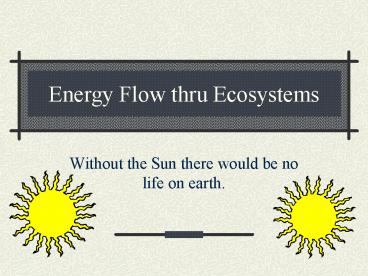Energy Flow thru Ecosystems - PowerPoint PPT Presentation
1 / 22
Title:
Energy Flow thru Ecosystems
Description:
Energy cannot be recycled, it flows through the ecosystem. ... plankton insect minnow small fish large fish - osprey. Food Webs ... – PowerPoint PPT presentation
Number of Views:71
Avg rating:3.0/5.0
Title: Energy Flow thru Ecosystems
1
Energy Flow thru Ecosystems
- Without the Sun there would be no life on earth.
2
Energy Facts
- The sun is the major supplier of the earths
energy. - Yet only 0.1 of the suns energy is used by
living organisms. - Plants use 1/2 of the energy they receive and
store the other as organic compounds. - Energy cannot be recycled, it flows through the
ecosystem. - Most of the energy released is lost in the form
of heat.
3
- The amount of solar energy collected by all
producers in an ecosystem is called primary
productivity. - Which ecosystem do you suppose has the highest
primary productivity desert, forest, swamp,
tundra, grassland?
4
Actually, even the energy of a campfire comes
from the sun. How?
Sun ? Photosynthesis ? Wood ? Campfire
5
Even the energy from a hydroelectric dam comes
from the sun. How?
Sun ? water evaporates ? rain ? river ?
hydroelectric dam
6
Even the energy captured by a windmill comes,
from the sun. How?
Sun ? unequal heating ? winds ? windmill
7
More about Energy Flow
- Decomposers are organisms that obtain there
energy from dead organic matter. - Organism eat organism at different levels.
- These levels are called trophic levels (feeding
level). - Ecosystems are made of many trophic levels.
- The amount of useable energy that is transferred
from trophic level to trophic level is approx.
10.
8
Energy Pyramids (Trophic Levels)
- The lowest trophic level of the pyramid
represents the producers and contains the most
energy. - The second level represents the primary
consumers, also called 1st order. A 90 decrease
in useable energy - The third level or secondary consumers will have
10 of the energy from the level below to use.
9
Thinking time.
- All first order consumers are also called what?
10
Lets Practice
- How many trophic levels are present?
- 5
- Determine the amount of useable energy for the
different trophic levels. - Level 2 36 J
- Level 3 3.6 J
- Level 4 0.36 J
- Level 5 0.036 J
11
Pyramid of Numbers
- Carnivore populations are smaller in comparison
to the rest of the ecosystem. - They require more food to sustain their lives
than the lower organisms.
10
Carnivores
200
Carnivores
100,000
Herbivores
200,000
Producers
12
Food Chain
- The simplest feeding arrangement in an ecosystem.
- Producers (autotrophs) are always at the base of
the chain. - The food chain may vary in length.
- Example Grass - cow - Human.
- Ex. plankton insect minnow small fish
large fish - osprey
13
Food Webs
- Many food chains interacting with each other.
- The arrow always points away from the organism
being eaten to the organism doing the eating. - Shows the movement of energy and matter in an
ecosystem.
14
Nutrient Cycles
- The suns energy drives most nutrient cycles.
- Much of the earths chemical nutrients are tied
up in many life forms. - The earths nutrients are finite, so they must be
recycled. - Examples Hydrologic, Carbon dioxide, and
Nitrogen Cycles.
15
Hydrologic Cycle
- Key terms
- Evaporation Liquid water changing state to a
gas. - Condensation Gaseous water changing state to a
liquid - Precipitation Water dropping from the sky.
- Transpiration Loss of water from plants.
- Run off Water not being absorbed into the
ground. - Ground water. Water found under ground
16
(No Transcript)
17
Carbon Cycle
- Key Terms
- Photosynthesis Autotrophs capture the suns
energy in organic compounds. - Respiration Organisms releasing the stored
energy from organic compounds. - Combustion Burning of organic compounds.
- Carbonic Acid An acid formed from carbon dioxide
and water. - Calcium Carbonate Chemical found making up bone
and shells.
18
(No Transcript)
19
Nitrogen cycle
- Plant and animal wastes decompose, adding
nitrogen to the soil. - Bacteria in the soil convert those forms of
nitrogen into forms plants can use. - Rain storms contribute atmospheric nitrogen (78)
through rain drops that reach the soil. - Legumes, such as soybeans, alfalfa and clovers,
are plants that can convert atmospheric nitrogen
into plant-usable nitrogen. - Factories that produce nitrogen fertilizers add
nitrogen to the soil when farmers and gardeners
"feed" their crops.
20
(No Transcript)
21
The Flow of Energy
- Since plants capture the suns energy and store
it in food, they are said to be producers. - The amount of solar energy collected by all
producers in an ecosystem is called primary
productivity. - Animals that receive their energy directly from
plants are called primary consumers (herbivores). - Consumers that feed on primary consumers are
called secondary consumers (carnivores). - Energy flows from the sun to the producer, then
to the primary consumer, then to the secondary
consumer, etc.
22
Review
- Producers -
- capture the suns energy and store it in
food. - Primary Productivity -
- amount of solar energy collected by all
producers in an ecosystem - Primary Consumer
- animals that receive their energy directly
from plants - Secondary Consumers
- Consumers that feed on primary consumers































